|
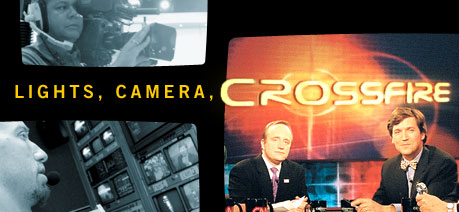
BY LAURA EWALD | PHOTOS BY CLAIRE DUGGAN
| |
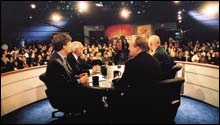 |
“We figure out the show as we go along. There are huge differences between broadcast and print journalism. Print is deep, contemplative, and you can explore—and exhaust—a topic. Television is exciting, fast, not easy to control, and that’s what makes it so interesting. It’ll wake you up.”
–Tucker Carlson, Crossfire Host
|
An undertone of excitement, created by everyone from laughing students in jean jackets to whispering business people in tailored navy suits, sweeps through GW’s Jack Morton Auditorium. Flashes from disposable cameras merge with the hot red, blue, and yellow studio lights, glinting off of sleek black studio equipment. The audience, armed now with wireless instant poll voting devices and pencils and paper for questions, listens intently to the director’s cues, then bursts into applause when the opening credits roll. It’s lights, it’s camera, it’s action. It’s CNN’s Crossfire at The George Washington University.
Facing off in the window of GW’s Media and Public Affairs Building, just outside the auditorium, stand a large, colorful elephant and whimsical donkey. Once part of last year’s “Party Animals” exhibit sponsored by the D.C. Commission on the Arts and Humanities, they now call GW their permanent home. Guarding the doors behind which the show airs live from 4:30 to 5 p.m. EST each weekday, these political icons also are a taste of the debates and banter audience members will soon experience.
Eighteen months have passed since the wit and weight of Crossfire permanently moved to campus, and, as of August, more than 60,000 people have attended the only political television show in the United States with a live studio audience. Political enthusiasts and passionate GW students create an electric audience. Mixing hot issues, politics, humor, strategy, and soap boxes, the show is “one of the best ways to see Washington at The George Washington University,” as Peter Konwerski, executive director for admin-istrative partnerships and assistant to the vice president of student and academic support services, said at a freshman orientation session.
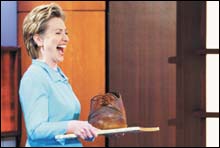
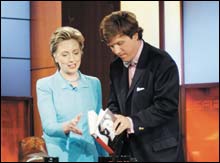 |
|
|
Sen. Hillary Rodham Clinton (D-N.Y.) pays a surprise visit to the set. Host Tucker Carlson said he would “eat his shoe” if the former first lady sold more than one million copies of her book Living History. When she passed the mark, Clinton brought Carlson a shoe-shaped cake, a “Right-wing tip.”
|
|
“I feel like I’m doing a Broadway show sometimes, it makes for a great studio experience,” says CNN Senior Executive Producer Sam Feist. “Politics is about winners and losers, who is in and who is out. This show brings our debate right to the middle of the nation’s capital. Tourists, Foggy Bottom residents, students from GW and visiting universities, faculty, and business groups get to connect with viewers—with voters—watching across the country.”
Working behind the scenes and learning from CNN staffers, few get closer to the action than GW students, who volunteer, intern, and take classes focusing on Crossfire. They have a unique broadcast perspective, as it is the only national, live weekday show airing from a college campus.
The set is a hands-on, intensely energetic classroom, and as Coordinating Producer Heather Clapp, BA ’98, says, one that benefits both students and CNN.
“Student involvement brings phenomenal energy to the show,” says Clapp, the liaison between GW and CNN. “There are more than 100 students who usher, help with the event side, and get a first-hand look at how a live television show is produced. It’s an amazing opportunity.”
This year, Clapp and Feist taught “Television Talk: An Introduction to Washington Public Affairs Programs,” part of GW’s School of Media and Public Affairs’ “Broadcast Summer” program. From guest booking to script writing, students gain real-world experience in the Crossfire learning lab.
On a hazy July afternoon, half an hour before show time begins, a few dozen students assist CNN experts with audience accommodations, camera set-up, sound checks, and the countless other tasks that must be performed before the cameras roll—live.
| |
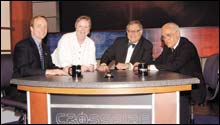 |
|
President Stephen Joel Trachtenberg drops by to celebrate the arrival of the 50,000th Crossfire audience member, Pam Adelson of Chicago.
|
|
The music of Pink Floyd and George Clinton and the Parliament Funkadelic set the groove as a cameraman puts weights on a roving jibb camera, which swoops over the rows of seats.
As he makes some adjustments, he spots a young woman watching interestedly just behind him.
“Hey, are you a student?”
“Yes.”
“Wanna learn how to run this thing?”
“Sure!”
Five minutes later, GW student Natalie Apsell is in control of the camera, moving it steadily with increasingly practiced hands.
Apsell and her fellow students are just a few of those who benefit from the CNN/GW partnership. CNN staffers and the show’s hosts—Paul Begala and James Carville on the Left, Bob Novak and Tucker Carlson on the Right—feed off the interest and participation of the live studio audience. Carlson says the show is propelled forward by the audience’s momentum.
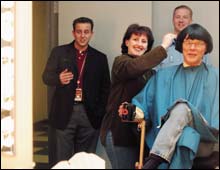 |
|
|
Host James Carville, left, lends his sense of humor to the backstage area as well as in front of the cameras, donning a wig. Carville enjoyed the wig so much he wore it during an on-camera show teaser as well as in the dressing room.
|
|
“Having a live audience and being at GW has changed the show completely,” says Carlson. “It’s actually relaxing for me to have the audience there. When you’re in a studio with just the cameras, you forget that you’re speaking to millions of people. With the audience there, and all that energy and excitement, we’re able to have some fun and know that our thoughts are being heard and supported.”
The merging of educational opportunities and audience feedback, which Clapp describes as “a brilliant partnership,” is made possible by the creativity and dedication of GW Vice President for Communications Michael Freedman. Through his contacts at CNN and his innovative ideas for the University, the former CBS broadcast executive paved the way for GW and Crossfire to connect.
When Freedman was considering leaving CBS for GW in 2001, he sought the counsel of his friend Rick Davis, then executive vice-president at CNN. Freedman discussed his interest in the then-unfinished Jack Morton Auditorium and its broadcast potential. Even before he accepted the GW position, Freedman was intrigued by the idea of airing Crossfire from GW.
“After I took the job here, I continued to talk about the idea with Rick Davis. We agreed to do a series of remote broadcasts from campus in mid- to late September 2001,” Freedman says.
But then, the unthinkable happened, and the vision changed.
“September 11 came and touched all of our worlds,” Freedman says. “It was highly unlikely that we would engage in the remote broadcasts. But then Rick called. We talked about doing a series of five ‘national town meetings’ with GW students representing young Americans in discussions about the tragedy.”
The televised town halls were so successful, both on-campus and across the country, that the project was extended an additional five nights.
| |
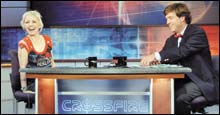 |
“We have a ton of fun with the audience,” Carlson says. “Whether they agree with you or not, it doesn’t matter. We all like being cheered on. We all have a great time.”
Actress Janeane Garofalo serves as guest host on the Left, facing off with host Tucker Carlson.
|
|
In late 2001, Davis put Freedman in contact with Feist who had taken over executive producer duties for the show.
“With the support and encouragement of President Trachtenberg and with the high interest on both sides, we negotiated the deal. It was as smooth as a negotiation can possibly be, and Sam is a dream partner,” Freedman says. “And finally, we launched on April 1, 2002. The rest, as they say, is history.”
Feist changed the show dramatically as it moved to campus. With an audience to work with every night, new segments focused on feedback were added to the show.
“Feedback is uniquely important to a political show, we take instant polls, have people weigh in and ask their questions and give their opinions,” Feist says. “We can take the answers to questions we ask live and cross-tabulate that with other useful data. It helps us know what America is thinking.”
“We have a ton of fun with the audience,” Carlson says. “Whether they agree with you or not, it doesn’t matter. We all like being cheered on. We all have a great time.”
The audience thoroughly enjoys the program as well, an aspect of the show that Clapp takes a moment to appreciate daily.
“One of my favorite parts of the show is standing at the back when people walk out, hearing their comments and seeing their smiles,” Clapp says. “I have a whole binder of thank-you notes in my office—cards from students, from businesses, from people visiting campus for the first time. It takes a special effort these days to write a note, and that’s one of the most rewarding parts of my job.”
Freedman says he attends the show at least twice a week and watches it every day. Though he has seen the show hundreds of times, he says he always gets a feeling of pride and excitement when he watches Crossfire.
“I am proud of the show. I have fun with it every day. And I’m proud of the GW staff and students for embracing Crossfire and making it a part of the fabric of their GW experience,” Freedman says. “While it’s not ‘the’ experience of GW, it is part of the greater whole. It’s one of the academic and enrichment opportunities that make the overall GW experience so special.”
And while—as students, parents, and alumni—many of the audience members have GW connections, Feist says Crossfire is an important part of the American experience overall.
“If you’re an American citizen, politics touches your life. And if politics touches your life, Crossfire touches you,” Feist says.
To reserve free tickets for the show, e-mail cnn@gwu.edu or call (202) 994-8266.
Back to top | Fall 2003 Table of Contents
|